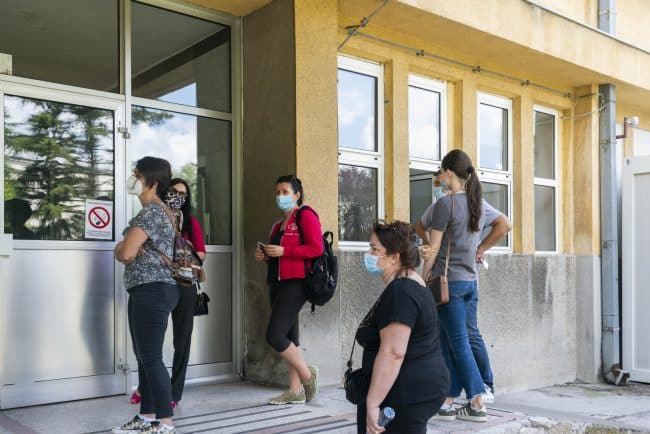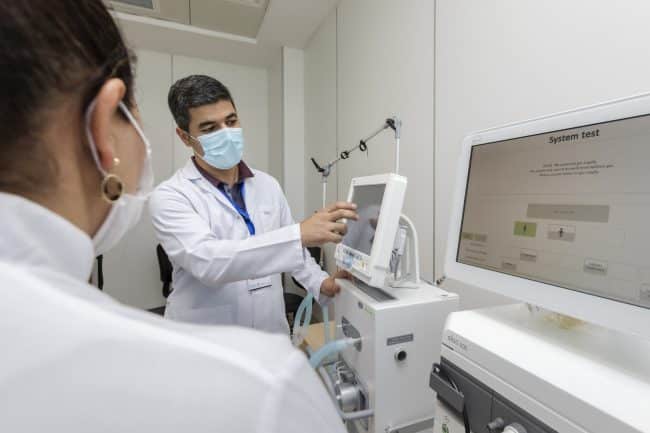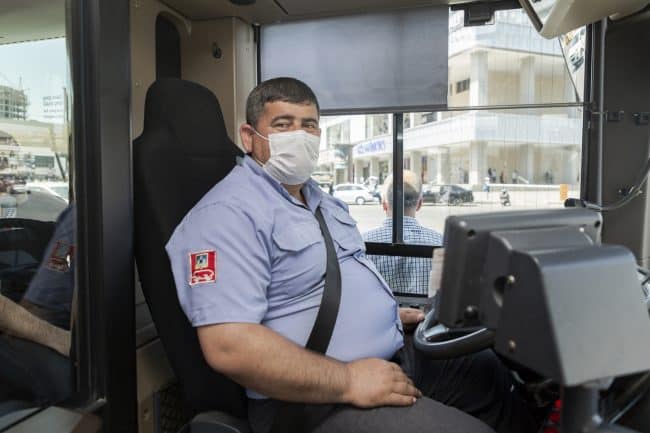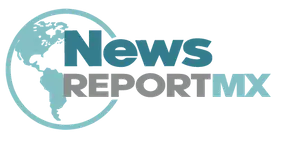A guide to WHO’s guidance
There’s a lot of information out there about how governments, health professionals and the general public should respond to the COVID-19 pandemic. WHO has published guidance and advice every step of the way.

COVID-19: MAURITIUS Testing for COVID-19 at the Jawaharlal Nehru Hospital (JNH). Samples are sent to the Candos Virology Lab in Quatre Bornes and results are received in around 2 days. This COVID-19 Testing Centre was set up with the support and guidance of the WHO country office in Mauritius. Frontliner Nungeta Sohun was working in endoscopy services before coming to the COVID-19 Testing centre at JNH Hospital. She was very anxious at the beginning about being in close contact with possible COVID-19 cases. Since the 15th of May she has been performing the rapid test for people that were to resume work.
During health emergencies like the COVID-19 pandemic, one of WHO’s most vital roles is to gather data and research from around the world, evaluate it, and then advise countries on how to respond.
WHO teams work with experts from around the world to develop this guidance. Together, the experts review reports, studies, presentations by countries, they analyse trends, consult further expert groups and then agree on the best approach. The guidance is meant for health decision makers who adapt the information for their country and context. As new scientific knowledge emerges, the documents are updated.
Since January 2020, WHO has published more than 100 documents about COVID-19. Of these, more than half are detailed technical guidance, on how to find and test cases, how to provide safe and appropriate care for people depending on the severity of their illness, how to trace and quarantine contacts, how to prevent transmission from one person to another, how to protect health care workers, and how to help communities to respond appropriately.

COVID-19 – Serbia
People line up outside Belgrades Torlak institute to be tested for COVID-19.
Reaching people with the information
WHO uses many platforms to reach people with the guidance, beyond publishing it online and sharing it directly through networks. It provides resources and regular updates for those working in professional sectors. WHO teams monitor social media and work with technology companies to get ahead of potential waves of misinformation.
WHO holds regular virtual press conferences from its headquarters in Geneva and its 6 regional offices around the world.
As of July 2020, more than 3.7 million people had enrolled in the OpenWHO platform, which has more than 100 free online courses about COVID-19 in 31 languages, including courses for health workers and other frontline responders.
Below is a summary of some of the documents WHO has developed for COVID-19 and how they can be used.
Preparing for an outbreak
For many years, WHO has been working with countries to prepare for a global pandemic, and has published guidance to help all countries prepare and brace for future outbreaks.
For countries where resources are scarce or where there’s risk of overwhelming a fragile health system, WHO has published guidance on COVID-19 preparedness and response in low capacity and humanitarian settings.
Building the capacity to find, isolate, test, safely monitor and care for COVID-19 patients is vital, and WHO has published a practical manual and online course detailing how to set up and manage a severe acute respiratory infection treatment centre. The manual covers everything from distancing in waiting areas to ventilation, rational use of personal protective equipment (PPE) and the recommended use of transparent surfaces. WHO has also published detailed guidance to help clinicians care for patients with COVID-19.

Living through an outbreak
WHO has outlined detailed guidance on how to find and test cases during different phases of the pandemic. In addition to case finding, contact tracing is essential in tracking and breaking chains of transmission of COVID-19. WHO provides technical guidance on contact tracing explains what constitutes a contact, how to identify contacts and how best to monitor contacts in quarantine.
When health systems are overwhelmed, both deaths directly from the outbreak and deaths as a result of vaccine-preventable and treatable conditions increase dramatically. Countries will need to make difficult decisions to balance the demands of responding to COVID-19 with the demands of maintaining the delivery of health services for sufferers of other illnesses. WHO has guidance and a list of actions that countries should consider in order to maintain access to high-quality essential health services for all.
Physical health injuries may be more noticeable than mental ones, but a global pandemic can have huge adverse effects on people’s mental health too. The booklet on mental health services during COVID-19 offers background and explanations for why maintaining mental health services is crucial in order to avoid a second global health emergency. It offers suggestions on assisting those who may be suffering, particularly those in vulnerable populations like frontline health workers and the ageing population.
Managing and ending an outbreak
As some countries look to ease restrictions, it’s important that they have access to all the information needed to ensure changes to behaviour are safe and managed. WHO has provided guidance on when and how to adjust large scale public health and social measures.
WHO has published a list of considerations for decisions about reopening schools. It outlines what questions should be answered before countries determine the status of education facilities. A similar document has been published on health measures in workplaces.
For densely populated urban centres, a comprehensive guide is available, listing the steps to both prepare for and respond to a potential COVID-19 outbreak. The guide includes real examples from cities around the world that have made necessary changes to their infrastructure in anticipation of an outbreak.

Public information is widely seen on billboards, posters and public transit. People displaying a variety of protective behavior and equipment move about the city.
Resuming activities during and after an outbreak
Restricting large gatherings has helped in limiting the spread of the virus. As some countries begin to allow gatherings again, it has never been more important to remain vigilant. For organizers of mass gatherings, the key planning recommendations from WHO outline the necessary precautions and safety measures when hosting large crowds of people.
For religious gatherings specifically, where close contact with others is common, guidelines have been published that include recommendations around devotion practices and conducting safe burials.
As restaurants continue to provide people with nourishment, food safety is of utmost importance. WHO has published guidance around food safety, including the use of plastic gloves, social distancing and meal delivery.
The common thread through the technical guidance is the need for governments to make informed decisions and to clearly communicate with their citizens. While some guidelines are universal – washing hands, maintaining distance, staying home if unwell with symptoms of COVID– others require a response tailored to specific contexts. WHO is committed to providing decision-makers with the information they need to make the best decisions for and with their people.
The technical guidance library is growing every week as scientific knowledge evolves. If the guidance is applied consistently and correctly, countries can not only learn to prevent and respond to current outbreaks, they can arm themselves with the necessary tools to fight health emergencies for generations to come.
The full library of technical documents published by WHO can be found here.
















